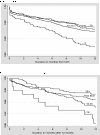Birth spacing and child mortality: an analysis of prospective data from the Nairobi urban health and demographic surveillance system
- PMID: 22958417
- PMCID: PMC3785173
- DOI: 10.1017/S0021932012000570
Birth spacing and child mortality: an analysis of prospective data from the Nairobi urban health and demographic surveillance system
Abstract
The majority of studies of the birth spacing-child survival relationship rely on retrospective data, which are vulnerable to errors that might bias results. The relationship is re-assessed using prospective data on 13,502 children born in two Nairobi slums between 2003 and 2009. Nearly 48% were first births. Among the remainder, short preceding intervals are common: 20% of second and higher order births were delivered within 24 months of an elder sibling, including 9% with a very short preceding interval of less than 18 months. After adjustment for potential confounders, the length of the preceding birth interval is a major determinant of infant and early childhood mortality. In infancy, a preceding birth interval of less than 18 months is associated with a two-fold increase in mortality risks (compared with lengthened intervals of 36 months or longer), while an interval of 18-23 months is associated with an increase of 18%. During the early childhood period, children born within 18 months of an elder sibling are more than twice as likely to die as those born after an interval of 36 months or more. Only 592 children experienced the birth of a younger sibling within 20 months; their second-year mortality was about twice as high as that of other children. These results support the findings based on retrospective data.
Figures
Similar articles
-
Birth spacing and infant and early childhood mortality in a high fertility area of Bangladesh: age-dependent and interactive effects.J Biosoc Sci. 1995 Oct;27(4):393-404. doi: 10.1017/s0021932000023002. J Biosoc Sci. 1995. PMID: 7593046
-
Birth spacing and child survival in rural Senegal.Int J Epidemiol. 1996 Oct;25(5):989-97. doi: 10.1093/ije/25.5.989. Int J Epidemiol. 1996. PMID: 8921485
-
Effects of infant feeding practices and birth spacing on infant and child survival: a reassessment from retrospective and prospective data.J Biosoc Sci. 1997 Jul;29(3):303-26. doi: 10.1017/s0021932097003039. J Biosoc Sci. 1997. PMID: 9881138
-
Impact of family planning programs in reducing high-risk births due to younger and older maternal age, short birth intervals, and high parity.Semin Perinatol. 2015 Aug;39(5):338-44. doi: 10.1053/j.semperi.2015.06.006. Epub 2015 Jul 10. Semin Perinatol. 2015. PMID: 26169538 Review.
-
The determinants of infant and child mortality in Tanzania.Health Policy Plan. 1995 Dec;10(4):384-94. doi: 10.1093/heapol/10.4.384. Health Policy Plan. 1995. PMID: 10154361 Review.
Cited by
-
Does Birth Interval Matter in Under-Five Mortality? Evidence from Demographic and Health Surveys from Eight Countries in West Africa.Biomed Res Int. 2021 May 15;2021:5516257. doi: 10.1155/2021/5516257. eCollection 2021. Biomed Res Int. 2021. PMID: 34055975 Free PMC article.
-
Determinants of modern contraceptive use among married women of reproductive age: a cross-sectional study in rural Zambia.BMJ Open. 2020 Mar 31;10(3):e030980. doi: 10.1136/bmjopen-2019-030980. BMJ Open. 2020. PMID: 32234737 Free PMC article.
-
Maternal reproductive history: trends and inequalities in four population-based birth cohorts in Pelotas, Brazil, 1982-2015.Int J Epidemiol. 2019 Apr 1;48(Suppl 1):i16-i25. doi: 10.1093/ije/dyy169. Int J Epidemiol. 2019. PMID: 30883655 Free PMC article.
-
Pregnancy intervals after stillbirth, neonatal death and spontaneous abortion and the risk of an adverse outcome in the next pregnancy in rural Bangladesh.BMC Pregnancy Childbirth. 2019 Feb 9;19(1):62. doi: 10.1186/s12884-019-2203-0. BMC Pregnancy Childbirth. 2019. PMID: 30738434 Free PMC article.
-
Contraceptive use among lactating women in Ganta-Afeshum District, Eastern Tigray, Northern Ethiopia, 2015: a cross sectional study.BMC Pregnancy Childbirth. 2017 Dec 16;17(1):421. doi: 10.1186/s12884-017-1613-0. BMC Pregnancy Childbirth. 2017. PMID: 29246123 Free PMC article.
References
-
- APHRC (African Population and Health Research Center) (2002) Population and Health Dynamics in Nairobi's Informal Settlements. African Population and Health Research Center, Nairobi, Kenya
-
- Black R. E., Morris S. S. & Bryce J. (2003) Where and why are 10 million children dying every year? The Lancet 361, 2226–2234 - PubMed
-
- Boerma J. T. & Bicego G. (1992) Preceding birth intervals and child survival: searching for pathways of influence. Studies in Family Planning 23, 243–256 - PubMed
Publication types
MeSH terms
LinkOut - more resources
Full Text Sources
Medical


